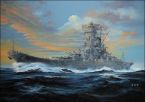Lecivius
Posts: 4845
Joined: 8/5/2007
From: Denver
Status: offline

|
As I wander about the net, I came across what to me appears to be 2 different views on the type 93 'Long Lance' torpedo.
In one http://www.navweaps.com/index_tech/tech-067.htm it is noted...
"The first is a review of the Type 93 torpedo by range fired, and speed setting employed. The dismal performance in such long-range actions as Java Sea and Komandorski Islands, and the relative success in the close-range actions of the Solomons Campaign, imply that the weapon’s speed was a greater asset than its range. It may be that the Japanese misappreciated their own weapon and would have been better served by a plan which eschewed “long-range concealed firing” in favor of short-range attacks that offered the enemy less time to evade.
The second is a review of Type 93 dud and depth control problems. Numerous Type 93s failed to explode, many others ran under their targets and others prematured in the wake pattern of the target ship. Without detailed information on impact angles, Type 93 fuze characteristics, and the number of weapons which passed harmlessly beneath their targets, reliable observations regarding these factors (so famously poor in US submarine and aerial torpedoes) are impossible. What little information I have on these phenomena suggests the Type 93 was not immune to these banes of the torpedo designer and employer. "
This implies the torpedo did experience some ( though nowhere near all) of the issues the US Navy had with theirs. Yet a counterpoint can be found at http://www.combinedfleet.com/torps.htm
"Designing and perfecting the Long Lance required solving some extremely difficult technical problems, most of which centered around the usage of pure oxygen as a fuel (rather than compressed air). Compressed air is nearly 77% nitrogen, which is useless for combustion, and also contributes to the visibility of the torpedo by leaving a bubble track on the surface. The usage of pure oxygen promised far greater power and propulsive efficiency, but it came with certain costs. The most glaring of these was how to use pure oxygen safely aboard a ship or submarine, given its inherently inflammable nature. Premature detonation of the torpedo upon firing was also a problem. However, the Japanese overcame these hurdles. Further, through meticulous live-testing of their weapons against ship targets, they perfected a warhead detonator that was rugged and reliable (The U.S. Navy's BuOrd could certainly have taken a lesson or two here). The resulting weapon, the Type 93 torpedo, was fantastically advanced in comparison with its Western counterparts, possessing an unequaled combination of speed, range, and hitting power. This weapon, coupled with the flexible battle tactics practiced by Japan's cruisers and destroyers, led to victory after victory in the early stages of the war. Only as American radar and gunfire control became increasingly sophisticated would the Japanese advantage in night battles begin to disappear, and even then a Long Lance-armed Japanese destroyer was still a thing to be feared."
While not exactly specific to the actual efficiency of the type-93, it does indicate it was relatively bug free. Also, the Long Lance was not that effective in anything other than (relatively) close combat. It was not the range, but the speed, that was the deciding factor in hits scored. To me this appears to be in conflict.
Does anyone have thoughts or valid opinions? Perhaps other sources?
|
 Printable Version
Printable Version












 New Messages
New Messages No New Messages
No New Messages Hot Topic w/ New Messages
Hot Topic w/ New Messages Hot Topic w/o New Messages
Hot Topic w/o New Messages Locked w/ New Messages
Locked w/ New Messages Locked w/o New Messages
Locked w/o New Messages Post New Thread
Post New Thread